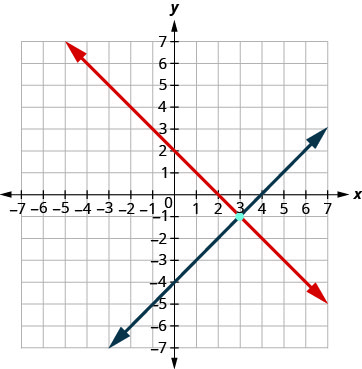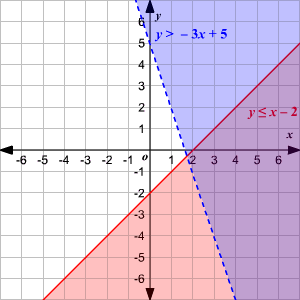to get y by itself in a system you must:
A.eliminate x
B. eliminate y
A. eliminate x
what is a system of equations?
two or more equations that can be solved together.
solve for y:
y= 10x + 2
x= 5
y= 52
can a graph have infintley many solutions?
yes
what is an inequality?
a relationship between two expressions or values that are not equal to each other
solve for y:
2x - 3y = 5
-2x - 4y = 30
y = -5
when solving systems you first must write them in:
standard form
solve the system of equations (both x and y)
-2x + y = 1
y= 2x + 3
no solution
what is the solution for this graph?

there is no solution
what color are the solutions located in for this graph?
purple
what is the solution for y?
2x + 3y = 20
-2x + y = 4
y=6
how many solutions does this system have?
3x + 2y = 10
4x - 2y = 4
one
solve for x:
y = 2x + 5x
x + y = 20
x = 2.9
does this graph have more than one soluton?

no
what is the solution for this graph?
no solution
solve for both x and y:
-2x - 9y = -25
-4x -9y = -23
(-1, -3)
put this system into standard form:
-12x + 7 = 35y
-12x + 35y = 7
solve for y:
y=5x + 1
y= -3x - 15
y= -39
how many solutions does this graph have?
one
does this graph match this inequality?
y < -x + 3 y > x -1
yes
solve the system for x:
6x - 5y = 2
4x + 3y = 10
x=1.5
what are the equations for these two tables?

y= 1.5x - 6
y= 4x + 6.1
solve the system of equations (both x and y)
y= 7 - 3x
y= 2x -8
(15 , 52)
what is the solution for this graph?

(2,2)
which of the following is a solution for this graph? (select two answers)
A. (-1, 2) B. (-6, 3) C. (4, 1) D. (-3, 6) E. (-5, 1)

C , D



